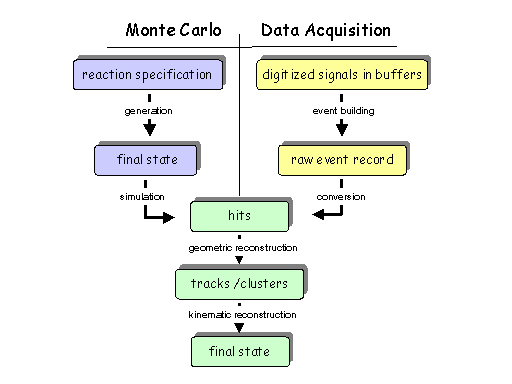
Hall D Internal Note
Richard Jones
May 25, 2001

<forwardTOF>
<slab y="float" repeat="*">
<side end="int" repeat="*">
<hit t="float" dE="float" repeat="*" />
</side>
</slab>
</forwardTOF>
<?xml version="1.0"?>
<HDDM class="s" version="1.0">
<physicsEvent eventNo="int" runNo="int">
<reaction type="int" weight="float" repeat="*">
<beam type="Particle_t">
<momentum px="float" py="float" pz="float" E="float" />
<properties charge="int" mass="float" />
</beam>
<target type="Particle_t">
<momentum px="float" py="float" pz="float" E="float" />
<properties charge="int" mass="float" />
</target>
<vertex repeat="*">
<product type="Particle_t" decayVertex="int" repeat="*">
<momentum px="float" py="float" pz="float" E="float" />
<properties charge="int" mass="float" />
</product>
<origin vx="float" vy="float" vz="float" t="float" />
</vertex>
</reaction>
</physicsEvent>
</HDDM>
<?xml version="1.0"?>
<HDDM class="s" version="1.0">
<physicsEvent eventNo="int" runNo="int">
<hitView version="1.0">
<barrelDC>
<cathodeCyl radius="float" repeat="*">
<strip sector="int" z="float" repeat="*">
<hit t="float" dE="float" repeat="*" />
</strip>
</cathodeCyl>
<ring radius="float" repeat="*">
<straw phim="float" repeat="*">
<hit t="float" dE="float" repeat="*" />
<point z="float" dEdx="float" phi="float"
dradius="float" repeat="*" />
</straw>
</ring>
</barrelDC>
<forwardDC>
<package pack="int" repeat="*">
<chamber module="int" repeat="*">
<cathodePlane layer="int" u="float" repeat="*">
<hit t="float" dE="float" repeat="*"/>
<cross v="float" z="float" tau="float" repeat="*" />
</cathodePlane>
</chamber>
</package>
</forwardDC>
<startCntr>
<sector sector="float" repeat="*">
<hit t="float" dE="float" repeat="*" />
</sector>
</startCntr>
<barrelCal>
<module sector="float" repeat="*">
<flash t="float" pe="float" repeat="*" />
</module>
</barrelCal>
<Cerenkov>
<module sector="float" repeat="*">
<flash t="float" pe="float" repeat="*" />
</module>
</Cerenkov>
<forwardTOF>
<slab y="float" repeat="*">
<side end="int" repeat="*">
<hit t="float" dE="float" repeat="*" />
</side>
</slab>
</forwardTOF>
<forwardEMcal>
<row row="int" repeat="*">
<column col="int" repeat="*">
<flash t="float" pe="float" repeat="*" />
</column>
</row>
</forwardEMcal>
</hitView>
</physicsEvent>
</HDDM>